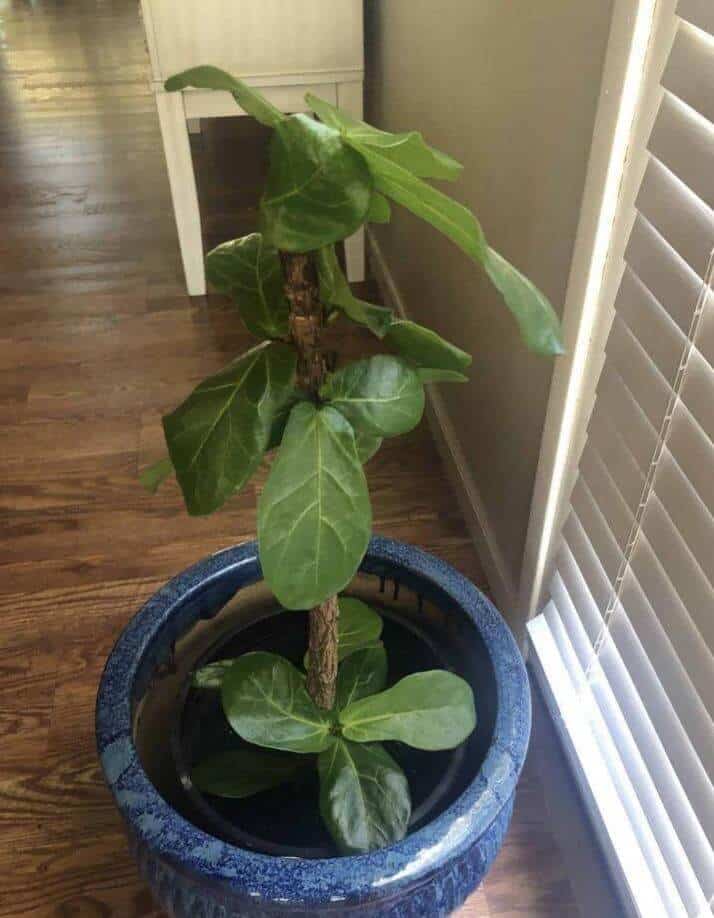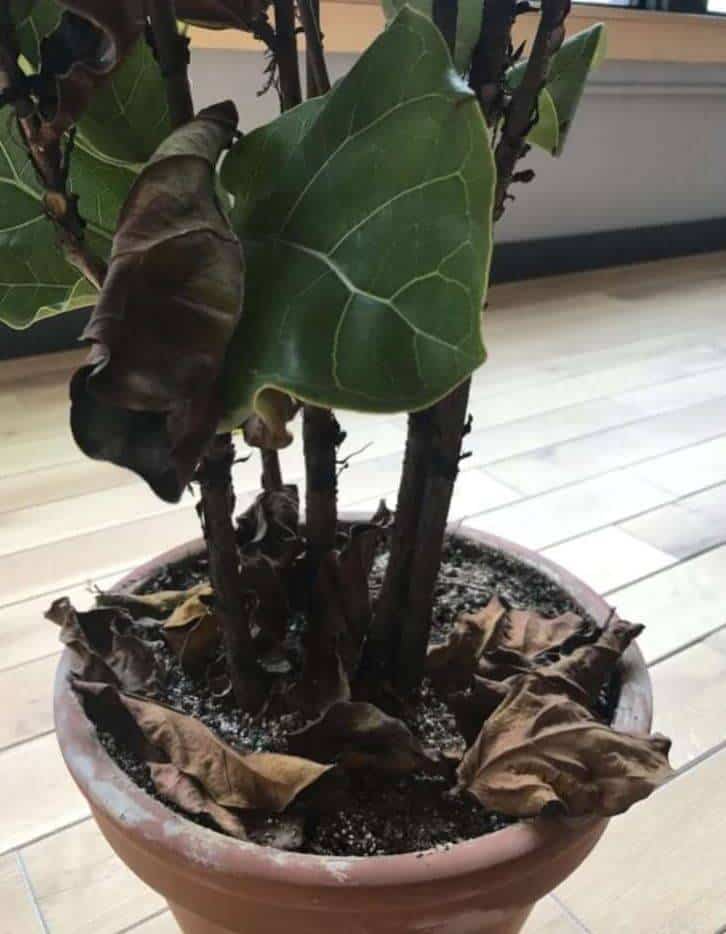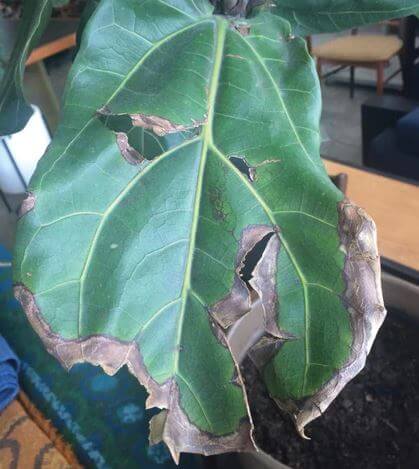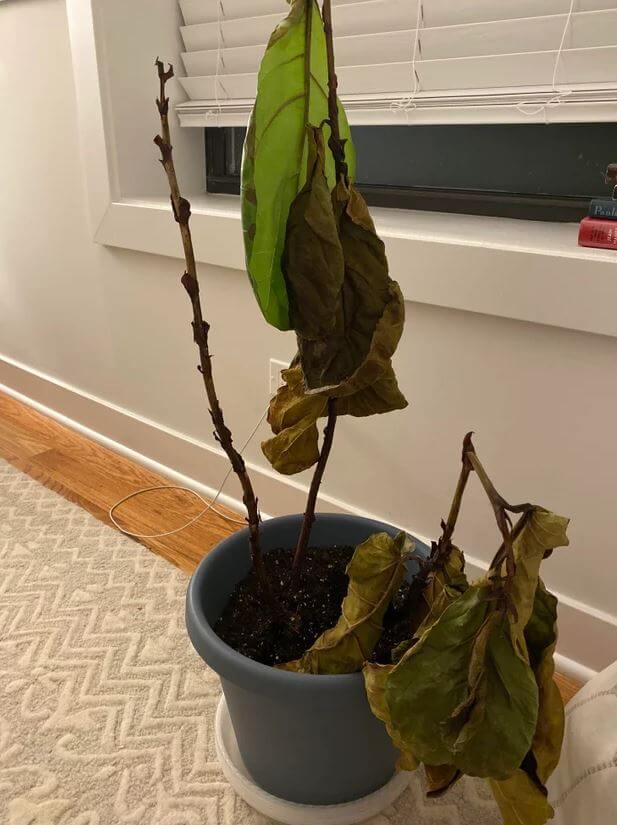Last Updated on May 24, 2023 by a Friendly Gardener
The Ficus lyrate or Fiddle Leaf Fig is an incredibly popular indoor houseplant (or tree!) that boasts large glossy green fiddle-shaped foliage with prominent veining. Indoor plants can grow to heights of ten feet making it an important decorating accent in the proper environment.
Members of the Moraceae plant family, are natives of tropical western Africa in wet, warm habitats. Resilient and undemanding, they do love bright filtered or indirect light, moderate moisture, and temperatures that range from 65° to 80°F.
When grown in proper environmental conditions, they are indeed glorious to behold, so when brown spots appear on leaves, or your tree begins dropping foliage, it can be a cause for alarm. You may fear your plant is dying and wonder how to save a dying fiddle leaf fig.
How to Save a Fiddle Leaf Fig

If your fig is looking a bit under the weather or worse, your initial task will be to assess its health. If the plant is dropping leaves, developing brown spots, or appears not to be growing, you may rightly wonder how to save a dying fiddle leaf fig or you may be tempted to throw it out and begin with a new plant.
First, consider the principal reasons your Fiddle Leaf Fig is dying to determine whether you may be able to save it. Usually, a Fiddle Leaf Fig will fall ill due to overwatering or drainage issues. However, as sensitive creatures, they will react to low humidity, changes in environmental temperatures, excessive sunlight exposure or inadequate sunlight, drought, and excessive fertilization. These plants are also sensitive to abrupt changes in their environment, so moving them too often is not recommended nor is frequent repotting.
How to revive a fiddle leaf fig will depend on recreating the conditions of the plant’s natural habitat, meaning temperature, humidity, and light exposure.
The Symptoms, Causes, and Solutions

-
Leaf Drop
The loss of foliage can be due to a variety of causes including overwatering, underwatering, excessive fertilizer in the soil bed, inadequate light, low humidity levels, temperature fluctuations, or transplant shock. Soggy soil, too little light, and overfeeding can all result in your fig dropping its leaves, especially the lower foliage, and may even cause the plant to lean.
However, very often, it is due to the plant being moved from one spot to another and causing a slight change in its environmental conditions. Drafts, air conditioning or heating vents, evening temperature drops, and heat waves can all cause foliage to drop.
What to Do
Position your plant in a room with bright indirect light and refrain from moving it around. Ascertain that you have a well-draining soil type. Water your fig only when the top two inches of soil feel dry and water thoroughly or do a soak allowing excess water to drain. Reduce watering during winter dormancy. Do not leave trays or saucers of water underneath your plant’s pot. Place your plant in a room with an average temperature between 65° and 80°F. and away from potential drafts. Mist your plant if you live in an arid climate or have dry house air. You can also introduce a space humidifier or group it with other plants to create a more humid microclimate. Feed your Fiddle Leaf Fig only during the growing season (spring and summer) with a fertilizer diluted to half strength.
-
Drooping Foliage

When leaves droop this can be a sign of inadequate light, overly warm temperatures, low humidity, overwatering or underwatering, and hydrophobic soil that the water will not penetrate so it does not reach the root system. Transplant shock can also cause leaves to begin drooping. The most common cause is inadequate light, so locations without natural light are not optimal for these plants.
What to Do:
Reproduce as best the environmental conditions of its natural habitat with bright, indirect light, proper temperatures, and watering. Mist your plant daily to aid the plant in recuperating necessary moisture. Position your plant in the brightest spot within your home and water thoroughly when topsoil is dry allowing excess water to drain from the pot. Make sure the water is infiltrating the soil well. If watering, humidity, and light are adjusted, the foliage should cease to droop within several days.
-
Brown Leaf Edges

The most common cause of brown edges is low humidity. Your Fiddle Leaf Fig needs a minimum of 40% environmental humidity. Underwatering can also provoke brown edges on leaves that begin to curl.
What to Do:
Ensure that the entire root system is receiving water and that the indoor temperature is in the preferred range. Mist your plant’s foliage daily or use a space humidifier. You can group several tropical plants to create a microclimate with increased humidity levels through transpiration. Soak your plant’s root ball always allowing excess water to drain completely. This is especially important if the soil repels the water. Soil often becomes hydrophobic because it has been allowed to dry out completely due to incorrect watering.
Brown edges can be trimmed following the leaf’s shape as they will not revert to green.
-
Brown Spots or Patches
Brown patches on foliage generally indicate overwatering or drainage issues. Overly damp soil beds create the conditions for root rot to set in. The top two inches of the soil should be allowed to dry out before watering is repeated. They also can appear because of scorching from the sun that is too harsh.
What to Do:
Ensure that your plant does have some shade or filtering of light. Prune off scorched or brown leaves. Ensure that soil is draining and that the plant has adequate drainage holes as drainage is essential for preventing root rot or other fungal infections.
Transplant Shock and Repotting

Fiddle Leaf Fig leaves may be drooping or dropping following repotting. These plants do not appreciate being moved, so often repotting will provoke a reaction. The sudden change in conditions can be fatal. If your fig is reacting poorly after transplanting, try to reproduce the ideal environmental conditions in terms of temperature, bright, indirect light, and watering. Mist stems and remaining foliage and place in a well-lighted spot. This will provide your plant with its best opportunity for recovery. Only repot in the spring, and do not repot in a significantly larger pot. Your new container should be only one size larger.
How to Revive a Dead Fiddle Leaf Fig
Because Fiddle Leaf Figs are highly sensitive to any environmental change or improper condition, it can be challenging to determine exactly what is causing your plant’s distress. It is important to check your watering habit and schedule, soil quality, room temperature, light conditions, humidity levels, and eventually fertilization.
If your plant’s poor condition follows a repotting, you will need to replicate the ideal environmental conditions as best as possible to give your plant a chance at recovery.

